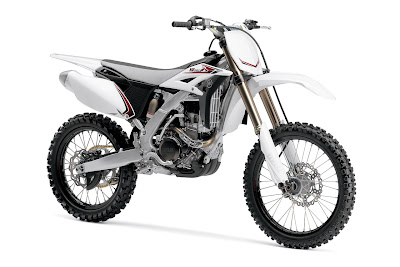The Yamaha YZ250F is hitting dealer floors in 2012 with a host of beefy upgrades to the nimble motocrosser. New design elements are found throughout the frame, engine, suspension and gearing giving the YZ250F an overhaul for the upcoming year.
Yamaha first started with the frame by adding a three-box tank rail section instead of its original two-box design for increased rigidity. The frame design also includes a new swingarm pivot point and new engine brackets for more predictable handling.
Housed within the new frame design is a re-worked engine. Yamaha opted for a lighter piston, piston pin and wire circlip. Yamaha claims the new piston gives better performance by reducing overall mass and friction, providing more power from 8000-12,000 rpm. Yamaha engineers also took into account vibration on the 250F, revising the crankshaft balancer to reduce the vibes felt at several key touchpoints including the handlebars, seat and footpegs. In addition, the balancer shaft is now optimized for the lighter piston, which further reduces vibration.
Biggest news for the 2012 model is what’s not changed, as the YZ remains the lone 250 to shun electronic fuel injection. Yamaha did tweak the carburetor, however, boring it out another 2mm, and a high-flow air filter cage has been fitted inside the 250F to enhance top-end performance. CDI settings have also been reformatted to give the bike better throttle response in the mid to high-speed range, and a new silencer with a smaller outlet is designed to meet AMA Pro Racing sound regulations.
Up front the KYB Speed Sensitive System fork is revalved and is now offset by 22mm. The outer tube has also been enhanced for 50% more rigidity, and the steering stem was made longer. The spring rate on the fork is now 0.46kg. The 250F’s rear shock sees new rebound damping and a new swingarm adds more strength to the axle block. Yamaha touts that these changes add more refined damping character and improve bump absorption, allowing for more aggressive sessions on the track.
news new and review about motorcycle
Popular Posts
-
The 2011 Aprilia RSV4 Factory APRC-SE created with the single-minded goal of being simply the best on the track and on the road, since its ...
-
2011 BMW HP2 Megamoto Thanks to its perfect geometry combined with the very finest technology, this high performance sports bike never get...
-
From ATV Quads News : KTM RC8 R Superbike riders were on top of their game on Sunday at the Oschersleben circuit in Germany when a double p...
-
The Street Bob® goes straight back to the minimalist roots of the bobber scene with launch 2011 Harley-Davidson FXDB Street Bob . Since its...
-
Unlike any other motorcycle available today, the 2011 Yamaha V-Max Base (VMX17) is truly in a class of its own. The awesome acceleration an...
-
Still out there are talking about the debut Valentino Rossi, Nicky Hayden and his team, who use the Ducati Desmosedici , in welcoming the Gr...
-
The 2011 Harley-Davidson FXDF Fat Bob® features a 130 mm wide front tire with a gnarly, robust tread pattern, emphasizing the aggressive ch...
-
110 years after the fi rst Indian Motorcycle® came to life, those legendary motorcycles that graced the highways and lonely back roads of t...
Copyright © 2013.
New Motorcycle
- All Rights Reserved











0 Comments :
Post a Comment